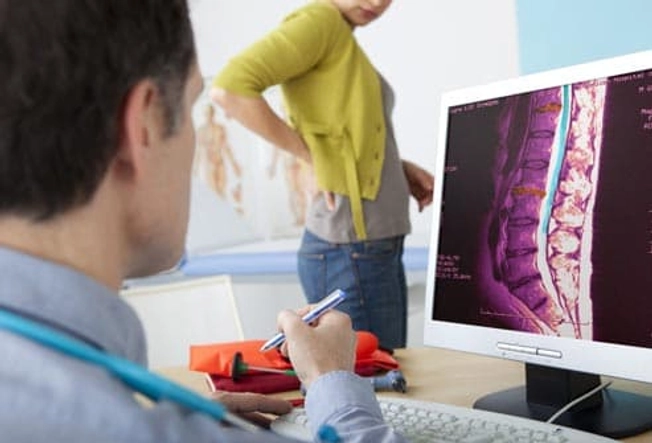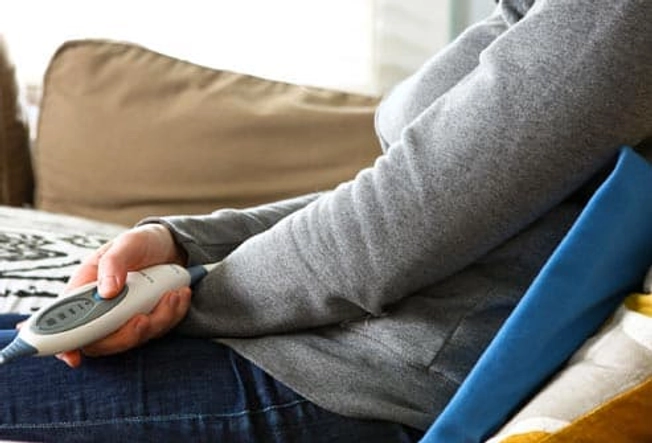Slideshow: A Visual Guide to Low Back Pain


What Is Low Back Pain?
The low back, also called the lumbar region, is the area of the back that starts below the ribcage. Almost everyone has low back pain at some point in life. It’s one of the top causes of missed work in the U.S. Fortunately, it often gets better on its own. When it doesn't, your doctor may be able to help with several effective treatments.

Symptoms of Low Back Pain
These might range from a dull ache to a stabbing or shooting sensation. The pain may make it hard to move or stand up straight. Pain that comes on suddenly is “acute.” It might happen during sports or heavy lifting. Pain that lasts more than 3 months is considered “chronic.” If your pain is not better within 72 hours, you should consult a doctor.

Symptoms That Require Urgent Care
See a health care professional any time you have back pain after a fall or injury. The same goes if you have back pain with bowel or bladder control problems, leg weakness, fever, or pain when coughing or peeing.

Muscle Strain or Sciatica?
Muscle strain is often the cause of back pain from heavy lifting or vigorous exercise. But sometimes it’s due to small jelly-filled disks meant to protect the space between vertebrae. When one of these disks bulges or breaks, it can push on a nerve. When it’s the sciatic nerve, pain runs from the buttock down one leg. This is sciatica.

Back Pain Culprit: Your Job
If your job involves lifting, pulling, or anything that twists the spine, it may contribute to back pain. However, sitting at a desk all day comes with risks of its own, especially if your chair is uncomfortable or you tend to slouch.

Back Pain Culprit: Your Bag
Although you may wear your purse, backpack, or briefcase over your shoulder, it is the lower back that supports the upper body -- including any additional weight you carry. So an overstuffed bag can strain the lower back, especially if you carry it day after day. If you must tote a heavy load, consider switching to a wheeled briefcase.

Back Pain Culprit: Your Workout
Overdoing it at the gym or golf course is one of the most common causes of overextended muscles leading to low back pain. You're especially vulnerable if you tend to be inactive during the work week and then spend hours at the gym or softball field on the weekend.

Back Pain Culprit: Your Posture
Moms were right when they said, "Stand up straight!" Your back supports weight best when you don't slouch. This means sitting with good lumbar support for your lower back, shoulders back, with feet resting on a low stool. When standing, keep weight evenly balanced on both feet.

Back Pain Culprit: Herniated Disk
The spine's vertebrae are cushioned by gel-like disks that are prone to wear and tear from aging or injuries. A weakened disk may rupture or bulge, putting pressure on the spinal nerve roots. This is known as a herniated disk and can cause intense pain.

Back Pain Culprit: Chronic Conditions
Several chronic conditions can lead to low back pain.
- Spinal stenosis is a narrowing of the space around the spinal cord, which can put pressure on the spinal nerves.
- Ankylosing spondylitis inflames the joints of the spine, and sometimes the shoulders, hips, ribs, and other areas too. It causes chronic back pain and stiffness. In serious cases, spinal vertebrae start to fuse (grow together).
- Fibromyalgia causes widespread muscle aches, including back pain.

Who's at Risk for Low Back Pain?
Most people experience back pain first when they're in their 30s. The odds of additional attacks increase with age. Other reasons your low back may hurt include:
- Being overweight
- Being sedentary
- Lifting heavy stuff on the job

Diagnosing Low Back Pain
To help your doctor diagnose the source of low back pain, be specific in describing the type of pain, when it started, related symptoms, and any history of chronic conditions. Your doctor will probably not need to order X-rays, CT or MRI scans before starting treatment.

Home Care for Low Back Pain
Back pain due to muscle strain will usually get better on its own, but you can take steps to make yourself more comfortable. A heating pad or warm baths may provide temporary pain relief.

The Bed Rest Debate
When your back hurts, you may not feel like getting out of bed. But if the problem is muscle strain, doctors recommend returning to your normal activities as soon as possible. Studies suggest that any more than a day or two of bed rest can actually make the pain worse and may reduce muscle tone and flexibility.

Yoga
If back pain doesn't go away in 3 months, there's evidence that yoga can help. In one study, people who took 12 weeks of yoga classes had less back pain than those who got a book about back pain. The benefits lasted several months. Just make sure you get expert instruction so you don’t hurt yourself.

Spinal Manipulation
Chiropractors and some osteopathic doctors may try to move the joints of your spine to treat low back pain. They apply pressure with their hands to bones and surrounding tissues. This treatment is not appropriate for everyone, so be sure to tell your provider about all your symptoms and health issues.

Massage Therapy
Massage may relieve chronic low back pain, especially when combined with exercise and stretching. Researchers noted patients who did all three were able to move around easier and had less short-term and long-term pain.

Acupuncture
Can acupuncture treat back pain? The evidence is mixed for people with short-term back pain. Research showed that these people benefited from sham acupuncture as much as from real acupuncture. However in other studies, people with chronic or long-lasting backpain did show improvement after receiving acupuncture treatments.

Medications
Mild back pain often feels better with over-the-counter pain relievers, such as acetaminophen, ibuprofen, or naproxen. Pain-relieving creams may be helpful for muscle aches. For severe pain or chronic pain, your doctor may recommend prescription medication.

Injections
If simpler therapies and medications aren't helping, your doctor may recommend injections to the back. One procedure, called a nerve root block, targets irritated nerves. Injections for back pain usually contain steroid medication.

Surgery
If long-lasting back pain is interfering with your daily life, and other treatments have not provided relief, you may be a candidate for surgery. Depending on the cause of your pain, a surgeon may remove a herniated disc, widen the space around the spinal cord, and/or fuse two spinal vertebrae together.

Physical Therapy
If back pain has left you inactive for a long time, a rehabilitation program can help you strengthen your muscles and get back to your daily activities. A physical therapist can guide you through stretches, strength exercises, and low-impact cardio that will help you be fitter without straining your back.

Strengthening the Back
Strength training can help your lower back. In flexion exercises, you bend forward to stretch and strengthen the muscles of the back and hips. In extension exercises, you bend backward to develop the muscles that support the spine. If you have back pain, talk to your doctor or physical therapist about exercises that are safe for you.

Preventing Low Back Pain
There's no sure way to prevent back pain as you age, but there are steps you can take to lower your risk:
- Stay at a healthy weight.
- Exercise regularly.
- Lift with your legs, not your back.
- Make sure your work station position isn't contributing to your pain.